Originally published by EarthSky.
 On December 4, Mercury reaches its farthest angular distance from the sun, known as greatest eastern elongation. On this date, it lies low in the southwest. Chart via John Jardine Goss/ EarthSky.
On December 4, Mercury reaches its farthest angular distance from the sun, known as greatest eastern elongation. On this date, it lies low in the southwest. Chart via John Jardine Goss/ EarthSky.
Mercury will reach its greatest elongation – its greatest apparent distance from the sun on the sky’s dome for this evening apparition – on December 4, 2023.
Mercury after sunset in late 2023
Where to look: Look west, in the sunset direction – shortly after sunset – for Mercury. The sun’s innermost planet will be challenging, even when Mercury is farthest from the sunset, and even for the more favored view from the Southern Hemisphere.
Greatest elongation: Mercury is farthest from the sun on ou4 sky’s dome – at greatest elongation – at 14 UTC on December 4, 2023 (8 a.m. CDT on December 4). At that time, Mercury is 21 degrees from the sun in our sky.
Brightness: Mercury was bright when it emerged in the evening sky during the second week of November. At that time, it was shining at -0.5 magnitude. At greatest elongation, Mercury shines only slightly more faintly at magnitude -0.3. It’s still brighter than most stars! In the evenings after greatest elongation, the innermost planet will rapidly fade as it sweeps up from behind Earth, in orbit around the sun, causing its illuminated side, or day side, to turn away from us. It’ll probably disappear by mid-December 2023 and will reach inferior conjunction – when it will pass between Earth and the sun – on December 22.
Through a telescope: Mercury will appear about 62% illuminated, at greatest elongation. It’ll measure 6.7 arcseconds across.
Constellation: Mercury will lie in front of the constellation Sagittarius the Archer at this elongation. Doubtless, most of the stars in this constellation will be lost in the twilight.
Note: As the innermost planet, Mercury is tied to the sun in our sky. As a result, it never ventures very far above the horizon after sunset. So as soon as the sun disappears below your horizon, your clock starts ticking. Will you see the glowing point of light that is Mercury before it drops below the horizon, following the setting sun?
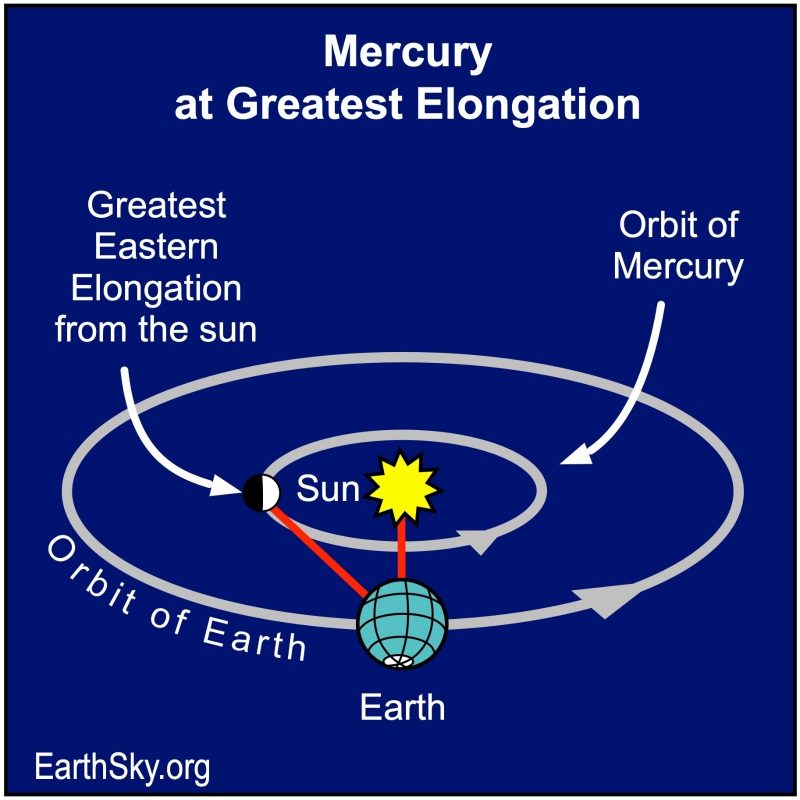 At greatest elongation, Mercury is to one side of the sun and is at its greatest distance from the sun on our sky’s dome. Mercury reaches greatest eastern (evening) elongation from the sun on December 4, 2023. It is 21 degrees from the sun in the evening sky. Chart via John Jardine Goss/ EarthSky.
At greatest elongation, Mercury is to one side of the sun and is at its greatest distance from the sun on our sky’s dome. Mercury reaches greatest eastern (evening) elongation from the sun on December 4, 2023. It is 21 degrees from the sun in the evening sky. Chart via John Jardine Goss/ EarthSky.
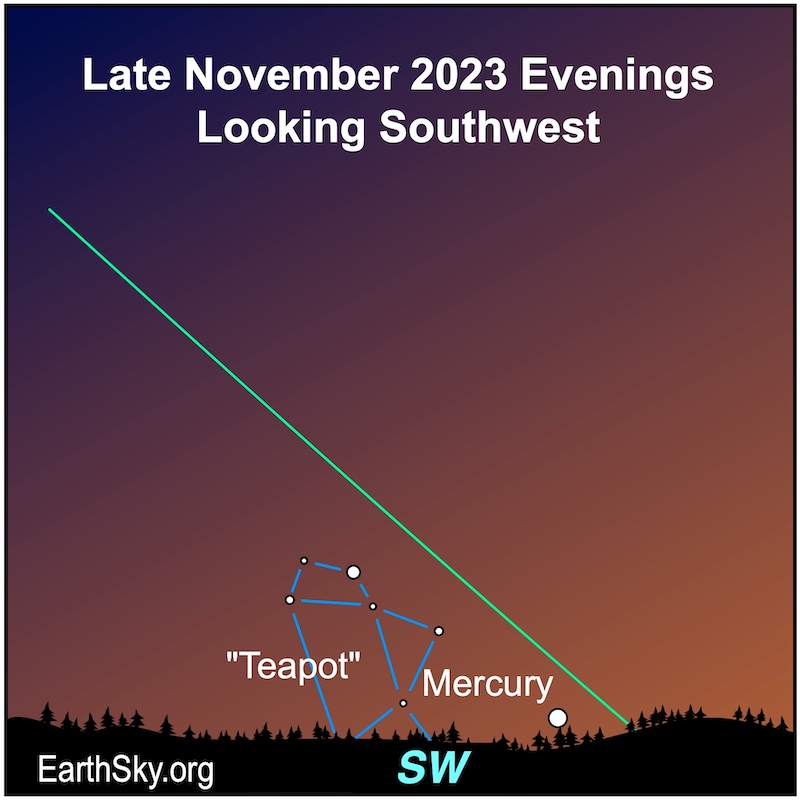 For viewers in the Northern Hemisphere, Mercury will lie just above the horizon in the bright twilight shortly after sunset in the second half of November 2023. The Teapot asterism of Sagittarius is nearby but it will be difficult to spot in the bright evening twilight. Chart via John Jardine Goss/ EarthSky.
For viewers in the Northern Hemisphere, Mercury will lie just above the horizon in the bright twilight shortly after sunset in the second half of November 2023. The Teapot asterism of Sagittarius is nearby but it will be difficult to spot in the bright evening twilight. Chart via John Jardine Goss/ EarthSky.
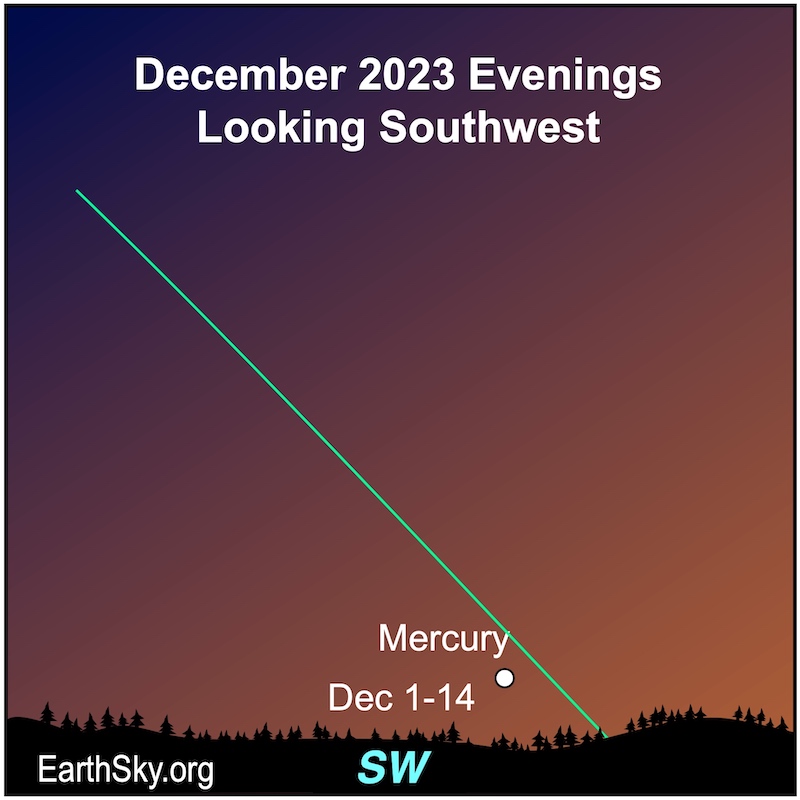 For viewers in the Northern Hemisphere, Mercury will lie just above the horizon in the bright twilight shortly after sunset in the first half of December 2023. Chart via John Jardine Goss/ EarthSky.
For viewers in the Northern Hemisphere, Mercury will lie just above the horizon in the bright twilight shortly after sunset in the first half of December 2023. Chart via John Jardine Goss/ EarthSky.
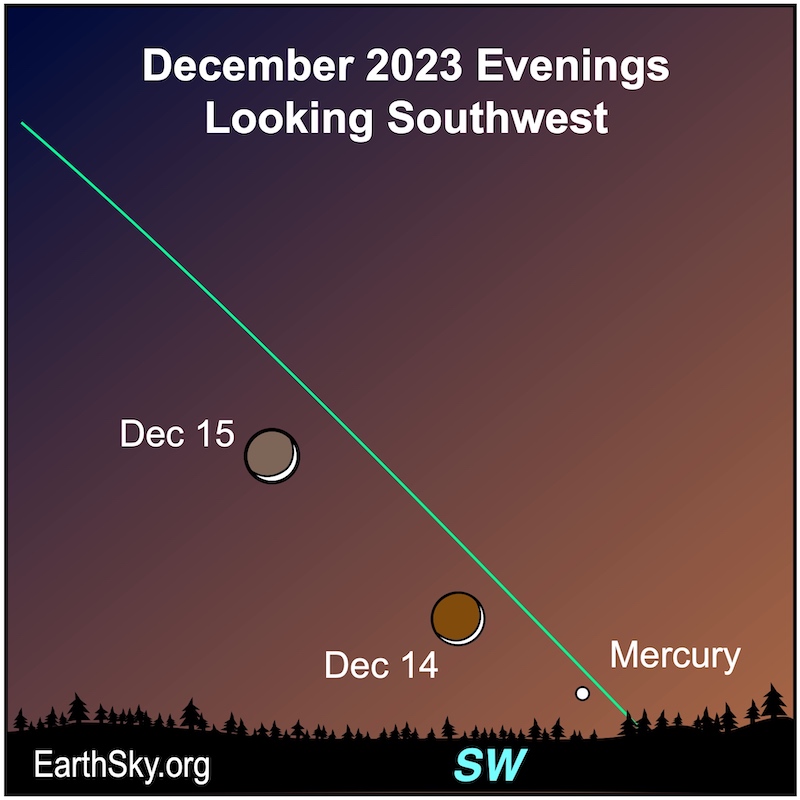 Viewers with a low southwestern horizon and clear skies will spot the very thin crescent moon floating in the bright twilight shortly after sunset on December 14 and 15, 2023. Mercury will lie to the moon’s lower right, very close to the horizon. Chart via John Jardine Goss/ EarthSky.
Viewers with a low southwestern horizon and clear skies will spot the very thin crescent moon floating in the bright twilight shortly after sunset on December 14 and 15, 2023. Mercury will lie to the moon’s lower right, very close to the horizon. Chart via John Jardine Goss/ EarthSky.
Finder charts for November Southern Hemisphere evenings
 During the second half of November 2023, Mercury will lie low in the west below the Teapot asterism of Sagittarius shortly after sunset. Chart via John Jardine Goss/ EarthSky.
During the second half of November 2023, Mercury will lie low in the west below the Teapot asterism of Sagittarius shortly after sunset. Chart via John Jardine Goss/ EarthSky.
 For viewers in the Southern Hemisphere, during the first half of December 2023, Mercury lies low in the west immediately below the Teapot asterism of Sagittarius shortly after sunset. Chart via John Jardine Goss/ EarthSky.
For viewers in the Southern Hemisphere, during the first half of December 2023, Mercury lies low in the west immediately below the Teapot asterism of Sagittarius shortly after sunset. Chart via John Jardine Goss/ EarthSky.
Mercury events in 2023 and 2024
Note: Times are in UTC
Jan 7, 2023: Inferior conjunction (races between Earth and sun)
Jan 30, 2023: Greatest elongation (morning)
Mar 17, 2023: Superior conjunction (passes behind sun from Earth)
Apr 11, 2023: Greatest elongation (evening)
May 1, 2023: Inferior conjunction (races between Earth and sun)
May 29, 2023: Greatest elongation (morning)
Jul 1, 2023: Superior conjunction (passes behind sun from Earth)
Aug 10, 2023: Greatest elongation (evening)
Sep 6, 2023: Inferior conjunction (races between Earth and sun)
Sep 22, 2023: Greatest elongation (morning)
Oct 20, 2023: Superior conjunction (passes behind sun from Earth)
Dec 4, 2023: Greatest elongation (evening)
Dec 22, 2023: Inferior conjunction (races between Earth and sun)
Jan 12, 2024: Greatest elongation (morning)
Feb 28, 2024: Superior conjunction (passes behind sun from Earth)
Mar 24, 2024: Greatest elongation (evening)
Apr 11, 2024: Inferior conjunction (races between Earth and sun)
May 9, 2024: Greatest elongation (morning)
Jun 14, 2024: Superior conjunction (passes behind sun from Earth)
Jul 22, 2024: Greatest elongation (evening)
Aug 19, 2024: Inferior conjunction (races between Earth and sun)
Sep 5, 2024: Greatest elongation (morning)
Sep 30, 2024: Superior conjunction (passes behind sun from Earth)
Nov 16, 2024: Greatest elongation (evening)
Dec 5, 2024: Inferior conjunction (races between Earth and sun)
Dec 25, 2024: Greatest elongation (morning)
Heliocentric view of Mercury December 2023
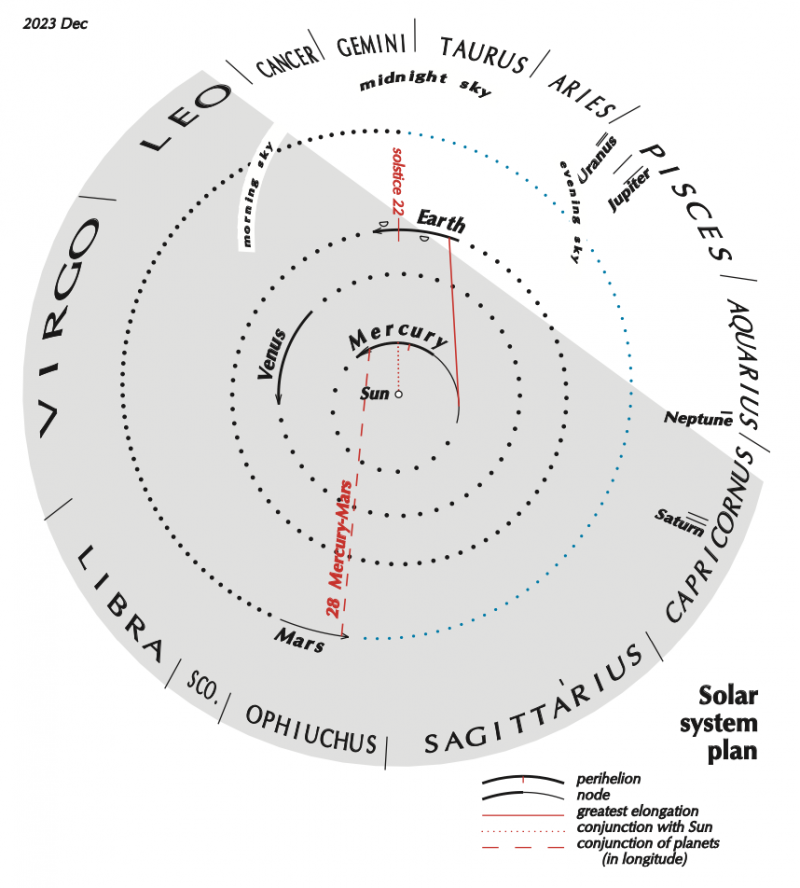 Heliocentric view of solar system, December 2023. Chart via Guy Ottewell Used with permission.
Heliocentric view of solar system, December 2023. Chart via Guy Ottewell Used with permission.
A comparison of elongations
The farthest from the sun that Mercury can ever appear on the sky’s dome is about 28 degrees. And the least distance is around 18 degrees.
Also, elongations are better or worse depending on the time of year they occur. So in 2023, the Southern Hemisphere had the best evening elongation of Mercury in August 2023. And the Northern Hemisphere had the best evening apparition in April.
In the autumn for either hemisphere, the ecliptic – or path of the sun, moon and planets – makes a narrow angle to the horizon in the evening. But it makes a steep slant, nearly perpendicular, in the morning. So, in autumn from either hemisphere, morning elongations of Mercury are best. That’s when Mercury appears higher above the horizon and farther from the glow of the sun. However, evening elongations in autumn are harder to see.
In the spring for either hemisphere, the situation reverses. The ecliptic and horizon meet at a sharper angle on spring evenings and a narrower angle on spring mornings. So, in springtime for either hemisphere, evening elongations of Mercury are best. Meanwhile, morning elongations in springtime are harder to see.
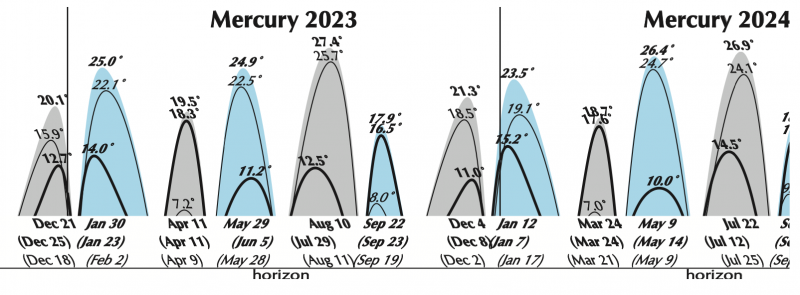 Mercury elongations compared. Here, gray areas represent evening apparitions (eastward elongation). Blue areas represent morning apparitions (westward elongation). The top figures are the maximum elongations, reached at the top dates shown beneath. Curves show the altitude of the planet above the horizon at sunrise or sunset, for latitude 40 degrees north (thick line) and 35 degrees south (thin). Maxima are reached at the parenthesized dates below (40 degrees north in bold type). Chart via Guy Ottewell’s 2023 Astronomical Calendar. Used with permission.
Mercury elongations compared. Here, gray areas represent evening apparitions (eastward elongation). Blue areas represent morning apparitions (westward elongation). The top figures are the maximum elongations, reached at the top dates shown beneath. Curves show the altitude of the planet above the horizon at sunrise or sunset, for latitude 40 degrees north (thick line) and 35 degrees south (thin). Maxima are reached at the parenthesized dates below (40 degrees north in bold type). Chart via Guy Ottewell’s 2023 Astronomical Calendar. Used with permission.
More Mercury elongation comparisons for 2023
 Mercury’s greatest evening elongations in 2023 from the Northern Hemisphere as viewed through a powerful telescope. The planet images are at the 1st, 11th, and 21st of each month. Dots show the actual positions of the planet for every day. Chart via Guy Ottewell. Used with permission.
Mercury’s greatest evening elongations in 2023 from the Northern Hemisphere as viewed through a powerful telescope. The planet images are at the 1st, 11th, and 21st of each month. Dots show the actual positions of the planet for every day. Chart via Guy Ottewell. Used with permission.
 Mercury’s greatest evening elongations in 2023 from the Southern Hemisphere as viewed through a powerful telescope. The planet images are at the 1st, 11th, and 21st of each month. Dots show the actual positions of the planet for every day. Chart via Guy Ottewell. Used with permission.
Mercury’s greatest evening elongations in 2023 from the Southern Hemisphere as viewed through a powerful telescope. The planet images are at the 1st, 11th, and 21st of each month. Dots show the actual positions of the planet for every day. Chart via Guy Ottewell. Used with permission.
Mercury photos from our community
 Joel Weatherly in Edmonton, Alberta, Canada, took this image on April 23, 2022. Joel wrote: “Lonely little Mercury is making an appearance in our evening skies. Despite being elusive, it was easy to see without optical aid once sighted.” Thank you, Joel!
Joel Weatherly in Edmonton, Alberta, Canada, took this image on April 23, 2022. Joel wrote: “Lonely little Mercury is making an appearance in our evening skies. Despite being elusive, it was easy to see without optical aid once sighted.” Thank you, Joel!
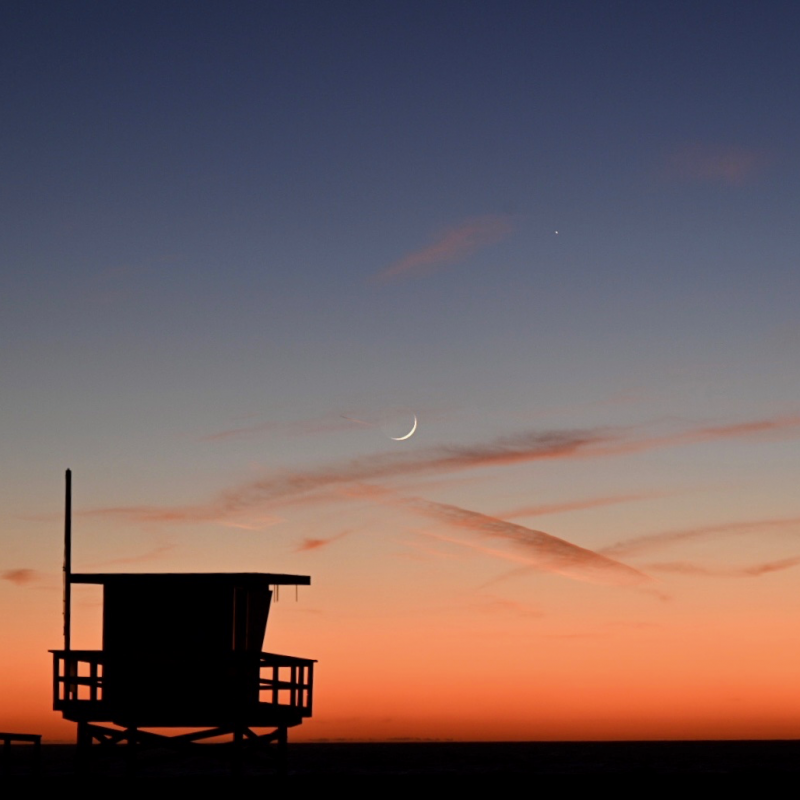 View at EarthSky Community Photos. | Chix RC captured this image on January 3, 2022, from Hermosa Beach, California. See Mercury to the upper right of the crescent? Chix wrote: “A faint young moon at 1% illumination and Mercury.” Thank you, Chix!
View at EarthSky Community Photos. | Chix RC captured this image on January 3, 2022, from Hermosa Beach, California. See Mercury to the upper right of the crescent? Chix wrote: “A faint young moon at 1% illumination and Mercury.” Thank you, Chix!
 Alexander Krivenyhev of the website WorldTimZone.com captured this photo of the moon together with Mercury and Venus on May 13, 2021, from Newport, Rhode Island. Thank you, Alexander!
Alexander Krivenyhev of the website WorldTimZone.com captured this photo of the moon together with Mercury and Venus on May 13, 2021, from Newport, Rhode Island. Thank you, Alexander!
Bottom line: Mercury is visible in the evening sky. Look in the west as the sky is darkening. The planet will reach its greatest elongation overnight on December 4, 2023.


